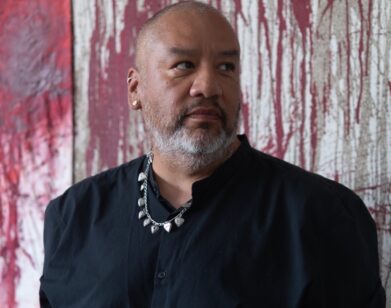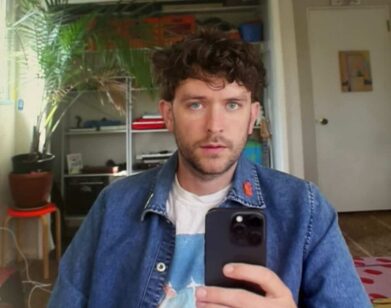A New Architectural Vision in Chicago

ABOVE: SARAH HERDA. PHOTO COURTESY OF JOE MAZZA.
The first-ever Architecture Biennial in North America opens this weekend in Chicago—a city that boasts buildings by renowned architects spanning multiple generations. Figures such as Daniel Burnham and Louis Sullivan built numerous structures in the late 1800s, while 20th century notables like Frank Lloyd Wright and Ludwig Mies van der Rohe spent much of their careers living and working within the Midwest city. In more recent decades, architects like Frank Gehry and artists such as Anish Kapoor have constructed public monuments and structures, including those within the centrally located Millennium Park. The first edition of the Chicago Architecture Biennial will highlight the city’s history, but also open the discussion to the present and future.
The CAB, entitled “The State of the Art of Architecture,” draws its name from a 1977 conference of the same name that invited leading American architects to Chicago to discuss exactly what the title suggests: the current state of the field. Expanding upon this notion, CAB Artistic Co-Directors Joseph Grima and Sarah Herda spent three years working with a curatorial team to develop a global roster of design and architectural firms. With more than 100 participants on the final list, the Biennial, which will run through January 3, 2016, becomes a citywide immersive experience. Aside from installations in the main exhibition hall at The Cultural Center, artists will also present projects and programming will take place at Millennium Park, Stony Island Arts Bank, the Graham Foundation, Expo 72, Water Tower Gallery, and the Illinois Institute of Technology. This weekend, we will speak with artists and designers on-site, but prior to the Biennial’s opening we spoke with Herda, who has now lived in Chicago for nearly 10 years (after serving as the Director of the Storefront for Art and Architecture in New York), to learn more about the process and planning behind CAB’s inauguration.
EMILY MCDERMOTT: I know you’ve been working on the program for three years, but can you tell me where it all began?
SARAH HERDA: It was a direct result of a cultural plan that the city undertook, which was a really extensive process to try to understand how to get art throughout the entire city. Through that process they identified architecture as the city’s most important cultural asset; they wanted to organize a major global cultural event in Chicago and the decision was made to focus on architecture. So very early on we started looking at the Venice [Architecture] Biennale as a model. Chicago is known for its legacy of architecture history, especially this specific and important moment in modernism—how do you do something that leverages that [legacy] but also makes something about the present and future? That’s what we started focusing on: the combination of using this incredible history to leverage a conversation about architecture today and where it’s going.
It was also different than choosing a theme: We didn’t want to assume that we knew everything that was important in the field today. We really wanted participants, people practicing in all parts of the world, to tell us what they thought was important.
MCDERMOTT: To start a dialogue…
HERDA: Exactly, which is a little bit different than a more standard curatorial model, which would be defining a theme and choosing people to prove your argument. We really wanted it to be this ground-up effort. We were actively working with a list of about 500 architects from around the world, reviewing their work and in contact with most. We really worked to create a snapshot of the field today. We were conscious of trying to get other voices in the mix, that it wasn’t just the establishment, or architects from the U.S. or Chicago or Europe, but trying to round out the conversation. If Venice was on our minds, we were also conscious that we were making a new platform for new voices—the list probably skews a little bit on the young side.
MCDERMOTT: I was going to ask, what do you think are some of the major differences between your event and Venice?
HERDA: I think that’s one: It’s carving out a new space for new voices in the field, and really working with them to figure out what they want to use this platform to say—for them to voice their position in architecture. This project demonstrates their ambition. We’re at nearly 100 projects right now and over 100 participants. The list just keeps growing. The work of building the exhibition of these projects has been finding relationships between projects and practices, and the interesting ways in which they are very different.
MCDERMOTT: You want the architects to speak about the most pressing issues in architecture right now. Did you have any preconceived ideas of what you would see? And now working on it, what are some of the recurring themes that have arisen?
HERDA: We went into it really open-minded. Of course we were both familiar with many of the practices, but we would both admit that there are people on the final list that neither one of us knew about before this started. We really wanted to be open minded, looking at new work. In a way, it’s articulating what is at the essence of practice today, and I would say that’s the diversity of voices. In different points in history, it might have been a certain ideological project, like modernism, post-modernism, the list goes on. But what we found is that there’s such a diversity of voices and positions. I think that really captures this moment.
Then there were things that I think were shared concerns, like the agency of the architect. So many of the people that we’ve included are really carving out a new space for architects to work. A lot of times that means self-initiative projects or that they’re findings ways in which architecture contributes to the discussion of social, political, and even aesthetic issues of the urban environment. There are some fundamental issues that society faces, like housing, the home, the almost basic notion of shelter and architecture providing that shelter in many different forms. We have a couple people who are building full-scale houses in the exhibition and they’re all very different models.
MCDERMOTT: Architects are building within the main exhibition hall, but you’re also doing events and installations throughout the city. Why did you want to make it an entirely immersive experience around the city, rather than a centralized showcase?
HERDA: We thought of the city as being the site of the biennial. It wasn’t about any one space. The Cultural Center is the hub, for sure, but we wanted a way to tap into the city itself and this legacy of architecture. It’s this city where you could walk down the block from the main exhibition and you could, on a one-to-one scale, experience a significant history of architecture. We also wanted to emphasize that the issues in the exhibition aren’t conversations you only need to have downtown, or in the cultural sector, but throughout the entire city. It’s the first biennial, so I think we have four or five sites, but over 90 partners in the city who will be producing programs.
THE CHICAGO ARCHITECTURE BIENNIAL OPENS TO THE PUBLIC ON SATURDAY, OCTOBER 3 AND WILL RUN THROUGH JANUARY 3, 2016. FOR MORE INFORMATION, VISIT CAB’S WEBSITE.






